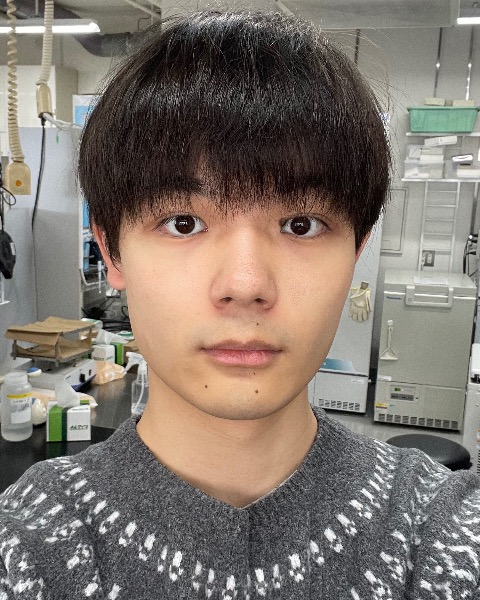Female Reproductive Tract
Poster Session A
(P-116) Complement Alternative Pathway Contributes to the Intrauterine Spermicidal Activity in Mice.
Wednesday, July 17, 2024
8:00 AM - 9:45 AM IST
Room: The Forum

Manato Sunamoto
master's degree program
Meiji university, Japan
Poster Presenter(s)
Abstract Authors: Manato Sunamoto1; Rina Sato1; Kazunori Morohoshi1,2; Ban Sato1; Kenji Miyado3; Natsuko Kawano1
1. Laboratory of Regulatory Biology, Department of Life Sciences, Graduate School of Agriculture, Meiji University, Kanagawa, Japan.
2. Division of Biomedical Engineering, National Defense Medical College Research Institute, Saitama, Japan.
3. Department of Reproductive Biology, National Research Institute for Child Health and Development, Tokyo, Japan.
Abstract Text: Mammalian fertilization occurs in the female reproductive tract. Although hundreds of millions of sperm are ejected into the female reproductive tract, only a few sperm reach the ampulla and participate in fertilization. During this process, we found that the uterine sperm was killed by uterine fluid without the protectant of seminal protein. The spermicidal effect was observed only in the estrus uterus, but not in the oviduct. We here focused on complement factor(s) as the spermicidal effect in the uterus. The expression of C3 that a central component of complement was increased in the uterus during estrus or in an E2-dependent manner, and treatment of uterine fluid at 56°C for 30 min attenuated the spermicidal effect. When the uterine fluid from C3 KO mice was added to sperm in vitro, sperm viability was not reduced compared to that from WT mice. On the contrary, the addition of only purified C3 did not show the spermicidal effect, suggesting that multiple proteins are involved in this effect. Moreover, we generated complement factor B (CFB)-deficient mice, which is essential for the complement alternative pathway activation. When the uterine fluid from Cfb KO mice was added to sperm in vitro, no spermicidal effect was observed as well as that from C3 KO mice. These results indicate that the female uterine fluid includes the factor(s) of complement alternative pathway and decreases the uterine sperm survival. As we previously reported, sperm without the protectant of seminal protein were dead in the uterus by artificial insemination, which would be due to the activation of complement alternative pathway. This is the first report that involvement of the complement pathway in sperm-uterus interaction. In the future, we would like to analyze in detail the relationship between the complement system and the sperm selection mechanism and immune tolerance in the uterus.
1. Laboratory of Regulatory Biology, Department of Life Sciences, Graduate School of Agriculture, Meiji University, Kanagawa, Japan.
2. Division of Biomedical Engineering, National Defense Medical College Research Institute, Saitama, Japan.
3. Department of Reproductive Biology, National Research Institute for Child Health and Development, Tokyo, Japan.
Abstract Text: Mammalian fertilization occurs in the female reproductive tract. Although hundreds of millions of sperm are ejected into the female reproductive tract, only a few sperm reach the ampulla and participate in fertilization. During this process, we found that the uterine sperm was killed by uterine fluid without the protectant of seminal protein. The spermicidal effect was observed only in the estrus uterus, but not in the oviduct. We here focused on complement factor(s) as the spermicidal effect in the uterus. The expression of C3 that a central component of complement was increased in the uterus during estrus or in an E2-dependent manner, and treatment of uterine fluid at 56°C for 30 min attenuated the spermicidal effect. When the uterine fluid from C3 KO mice was added to sperm in vitro, sperm viability was not reduced compared to that from WT mice. On the contrary, the addition of only purified C3 did not show the spermicidal effect, suggesting that multiple proteins are involved in this effect. Moreover, we generated complement factor B (CFB)-deficient mice, which is essential for the complement alternative pathway activation. When the uterine fluid from Cfb KO mice was added to sperm in vitro, no spermicidal effect was observed as well as that from C3 KO mice. These results indicate that the female uterine fluid includes the factor(s) of complement alternative pathway and decreases the uterine sperm survival. As we previously reported, sperm without the protectant of seminal protein were dead in the uterus by artificial insemination, which would be due to the activation of complement alternative pathway. This is the first report that involvement of the complement pathway in sperm-uterus interaction. In the future, we would like to analyze in detail the relationship between the complement system and the sperm selection mechanism and immune tolerance in the uterus.
